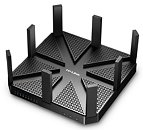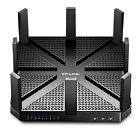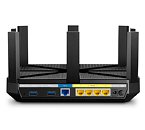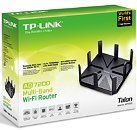Wednesday, May 18th 2016

TP-Link Announces the World's First 802.11 ad Router, The Talon AD7200
TP-LINK, a leading global provider of consumer and business networking products, today announced the availability of Talon AD7200, the world's fastest router with the latest, most powerful wireless technology available, 802.11ad. Talon AD7200 routers run a new 60GHz band that reaches speeds significantly faster than Gigabit Ethernet. Users can now download 100 photos in less than a second, an HD movie in less than 40 seconds and a full 4K movie in less than eight minutes-all over an interference-free home wireless network. The Talon AD7200 is currently available at Newegg.com, Fry's Electronics and Micro Center retail stores.
"With the Talon AD7200, we've bringing consumers the fastest Wi-Fi ever made," said Lewis Wu, executive vice president of TP-LINK USA. "We're excited to see the response from our customers when they are able to stream and download 4K movies in the blink of an eye, or transfer huge files and photos in seconds. It's a completely different experience than most of us are used to from our network, and we're excited to deliver this innovative technology to the world for the very first time.""802.11ad technology powers a brand new class of experiences in the connected home, including lag-free wireless docking, multiple 4K video streams, and instantaneous content sharing, gaming and downloading," said Chris Taylor, director of RF and wireless components, Strategy Analytics. "We expect that Wireless AD technology will continue to gain traction with consumers who need high-bandwidth interoperability in high-density environments."
Multi-Band & Leading Antenna Design for Whole-Home Coverage
As the number of Wi-Fi devices in the home steadily rises, consumers will require faster, most reliable Wi-Fi to manage the high bandwidth across their home network. The Talon AD7200 runs multiple bands at an unprecedented 7.2 Gbps to provide complete coverage for all your devices.
The new 60GHz (4600Mbps) band is a perfect single-room Wi-Fi solution that supports more simultaneous connections without interference. On top of 60GHz, the router's 5GHz (1733Mbps) and 2.4GHz (800Mbps) bands cover the rest of your home in powerful AC2600 Wi-Fi.
The Talon AD7200 uses eight high-gain antennas-seven external, one internal-as well as an external 60GHz antenna array to create strong Wi-Fi connections across your home. Beamforming helps the router locate Wi-Fi devices and focus its wireless signal in their direction.
Reliable Connections & Better Performance
The 60GHz band uses beam-steering technology to detect objects and direct the Talon AD7200's Wi-Fi along the clearest path to devices. If there's something between the router and a wireless device, like a chair or couch, beam-steering sends Wi-Fi around it for a stronger connection.
MU-MIMO allows the Talon AD7200 to simultaneously communicate with multiple devices on its 2.4 GHz and 5 GHz bands, reducing wait times and speeding up connections. With MU-MIMO, more users can be online at once without affecting the router's performance.
Faster Speeds & A More Powerful Network
A 1.4GHz dual-core processor balances the demands of your devices to keep their connections fast and uninterrupted. Four-Stream creates faster Wi-Fi connections by adding an extra data stream to both the Talon AD7200's 5 GHz and 2.4 GHz bands. The four total streams per band greatly increases Wi-Fi speed, letting you enjoy intensive activities, like gaming or watching movies in 4K, without lag.
Now, you can game online, stream movies, download files and share media while the powerful dual-core processor seamlessly manages each Wi-Fi band, every connection and all of the router's hardware and software.
Key Features:
The Talon AD7200 Multi-band Wi-Fi Router with a MSRP of $349.99 USD is available exclusively online at NewEgg.com and exclusively in-store at Fry's and Microcenter retail locations.
For more information, visit the product page.
"With the Talon AD7200, we've bringing consumers the fastest Wi-Fi ever made," said Lewis Wu, executive vice president of TP-LINK USA. "We're excited to see the response from our customers when they are able to stream and download 4K movies in the blink of an eye, or transfer huge files and photos in seconds. It's a completely different experience than most of us are used to from our network, and we're excited to deliver this innovative technology to the world for the very first time.""802.11ad technology powers a brand new class of experiences in the connected home, including lag-free wireless docking, multiple 4K video streams, and instantaneous content sharing, gaming and downloading," said Chris Taylor, director of RF and wireless components, Strategy Analytics. "We expect that Wireless AD technology will continue to gain traction with consumers who need high-bandwidth interoperability in high-density environments."
Multi-Band & Leading Antenna Design for Whole-Home Coverage
As the number of Wi-Fi devices in the home steadily rises, consumers will require faster, most reliable Wi-Fi to manage the high bandwidth across their home network. The Talon AD7200 runs multiple bands at an unprecedented 7.2 Gbps to provide complete coverage for all your devices.
The new 60GHz (4600Mbps) band is a perfect single-room Wi-Fi solution that supports more simultaneous connections without interference. On top of 60GHz, the router's 5GHz (1733Mbps) and 2.4GHz (800Mbps) bands cover the rest of your home in powerful AC2600 Wi-Fi.
The Talon AD7200 uses eight high-gain antennas-seven external, one internal-as well as an external 60GHz antenna array to create strong Wi-Fi connections across your home. Beamforming helps the router locate Wi-Fi devices and focus its wireless signal in their direction.
Reliable Connections & Better Performance
The 60GHz band uses beam-steering technology to detect objects and direct the Talon AD7200's Wi-Fi along the clearest path to devices. If there's something between the router and a wireless device, like a chair or couch, beam-steering sends Wi-Fi around it for a stronger connection.
MU-MIMO allows the Talon AD7200 to simultaneously communicate with multiple devices on its 2.4 GHz and 5 GHz bands, reducing wait times and speeding up connections. With MU-MIMO, more users can be online at once without affecting the router's performance.
Faster Speeds & A More Powerful Network
A 1.4GHz dual-core processor balances the demands of your devices to keep their connections fast and uninterrupted. Four-Stream creates faster Wi-Fi connections by adding an extra data stream to both the Talon AD7200's 5 GHz and 2.4 GHz bands. The four total streams per band greatly increases Wi-Fi speed, letting you enjoy intensive activities, like gaming or watching movies in 4K, without lag.
Now, you can game online, stream movies, download files and share media while the powerful dual-core processor seamlessly manages each Wi-Fi band, every connection and all of the router's hardware and software.
Key Features:
- Wireless AD: Supports 802.11ad, the latest breakthrough in wireless technology, for Wi-Fi speeds faster than Gigabit Ethernet
- AD7200 Multi-Band: Runs three separate Wi-Fi bands, 60GHz (4600Mbps), 5GHz (1733Mbps), and 2.4GHz (800Mbps)
- Leading-edge antenna design: Creates superior Wi-Fi coverage with eight external antennas, beamforming, and beam-steering
- Future-proof your network: Works with all existing Wi-Fi devices and all future Wireless AD devices
- MU-MIMO: Communicates with several devices at once to reduce wait times and speed up connections
- 4-Stream: Increases overall wireless speeds by adding an extra data stream to the 2.4GHz and 5GHz Wi-Fi bands
- 1.4GHz dual-core processor: Handles multiple connections at the same time to keep your network running at peak performance
- Gigabit Ethernet: Create fast, reliable wired connections with four Gigabit Ethernet ports
- Dual USB 3.0 ports: Transfers files, music, movies, and photos on attached drives across your network at incredible speed
- VPN: Securely access files on devices connected through USB and Wi-Fi from anywhere
- Guest Network: Provides visitors with Wi-Fi access separate from your main network
- Parental Controls: Manage when and how connected devices can access the Internet
- Tether: Makes it easy to manage your Wi-Fi settings anywhere with the free TP-LINK Tether app (Android, iOS)
The Talon AD7200 Multi-band Wi-Fi Router with a MSRP of $349.99 USD is available exclusively online at NewEgg.com and exclusively in-store at Fry's and Microcenter retail locations.
For more information, visit the product page.




36 Comments on TP-Link Announces the World's First 802.11 ad Router, The Talon AD7200
It's just following the trend of first to market, and we are the vendor with the fastest "insert bleeding tech here".
In reality, if your clients (phones, PC's, consoles, tablets etc...) don't support that tech also, then it goes unused.
- AD7200 Multi-Band: Runs three separate Wi-Fi bands, 60GHz (4600Mbps), 5GHz (1733Mbps), and 2.4GHz (800Mbps)
All of those bands represent a ceiling that is higher than majority of your clients in the wild. Only a few select aftermarket add-on cards car support the 800 and 1300 on 5GHZ. Asus is JUST now releasing a Client card for PCIe that does 1733 even though they have been selling 1733 routers for over a year now.I'm still on N because my phone and laptops do not even support AC, I also bought an Asus wifi N card for my new desktop not long ago.
N still works fine for me!
"The new 60GHz (4600Mbps) band is a perfect single-room Wi-Fi solution..."
This is a total waste of time
Its just a Sales Gimmick
what consumers want is greater range and throughput on current standards
not to have to invest in more upgrades
soon they will release a standard @high enough Htz that it will be super super fast but have a range on cm's and sheets of paper will block signals
What use is Wi fi if it will not connect from other rooms in your home
PS the answer is like tits on a Bull
There's only one router that has Link Aggregation, which allows using two ethernet ports and connecting them to a compatible NAS/HomeServer/Switch so these can serve the full speed ( either one of them or combined for multiple clients )
the only router is the Nighthawk X8... I hope other makers jump into this also...
Also, I think this is mostly for bragging rights. AC has yet to take over the majority of the market in both home usage and business.
AD is line of sight with no walls.
I'll stick with AC and N no thanks!
Also TP link blocks 3rd Party firmware I wouldn't take it if I got it for free.
Seriously tho who needs that? Unless you plan to suck internet dry in a week then go ahead. :)